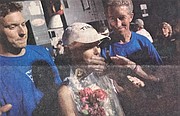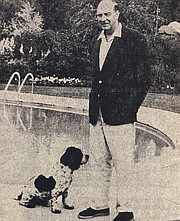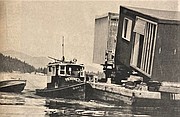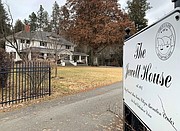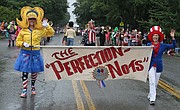HUCKLEBERRIES: Rooster tails and screaming engines
DAVE OLIVERIA | Coeur d'Alene Press | UPDATED 1 year, 8 months AGO
It was Car d’Lane, Ironman and Art on the Green rolled into one.
Coeur d’Alene was all in. The unlimited hydroplane owners and drivers were all in, too.
The only dark lining shadowing the silver cloud for the first Diamond Cup that June 28-29, 1958, was June’s unpredictable weather.
After a pell-mell, two-month rush to prepare a 3-mile racecourse and pit area, the city of Coeur d’Alene opened its arms to national media and its first hydroplane races. And the rain came down. And then the wind blew away the first day of the weekend event.
But that Sunday, June 29, the weather obliged and Lake Coeur d’Alene’s surface steadied as six of the original 12 thunder boats charged across the starting line in the 30-mile race finale. Rooster tails and screaming engines thrilled an estimated 35,000 spectators watching from Tubbs Hill, on the lakeshore, and in boats lined along log booms.
Maverick, piloted by Bill Stead, shot to the front in the first lap and never relinquished the lead in winning that first Diamond Cup. Owner Bill Waggoner of Phoenix, Ariz., pocketed $1,000 for the victory, along with the 3-foot-tall Diamond Cup and bragging rights.
Stead and the Maverick would win again in 1959 as the Diamond Cup began a successful decade-long run, plagued only by unruly Saturday night crowds from 1961-64.
The Diamond Cup drew national attention and visitors to Coeur d’Alene, as organizers had hoped. Also, the races heightened local awareness of the under-appreciated waterfront.
The Diamond Cup has passed into legend, hailed by fans as a bit of paradise lost, denounced by detractors as a magnet for troublemakers. But, 65 years ago, it was a source of community pride and a time when this town’s movers and shakers got things done.
Last, not least
Ironman Coeur d’Alene fans know that a course record was set last Sunday by Chris Leiferman of Boulder, Colo., a new father whose daughter, Levi, was born the week before.
His time of 8 hours, six minutes, and 42 seconds bested the old mark by a minute. And beat by 34 minutes the time set by Michael Lovato, also of Boulder, in the first Ironman here June 29, 2003. And it was almost nine hours faster than the time recorded by Carol Travis that first year.
Carol? In the inaugural race, the local woman was 54 years old and competing in her first Ironman, along with husband Bill. The Travises were part of a field of 1,576 that faced searing heat, high humidity, and a brief thunderstorm. Carol doubted at times during the triathlon that she would finish in the allotted 17 hours.
As the clock ticked down to midnight on Sherman Avenue that Sunday, Carol reportedly “pumped her arms and charged ahead” over the final 200 yards to become the final competitor to qualify, with 5 ½ minutes to spare, Ironman No. 1,343.
Finally, Carol heard the magic words, “You Are an Ironman,” an affirmation that levels the field between first and last, between pro and inspirational first-timer. And something qualifiers will forever be.
A big deal
Charles C. Finucane (fin-uke-inn), for whom Finucane Park in Hayden is named, was a VIP — a former Undersecretary of the Army who was nominated in 1958 by President Eisenhower to be assistant Secretary of Defense. He was waiting for Senate confirmation 65 years ago when he was selected to emcee the awards banquet for the first Diamond Cup race. He was impressed by the community spirit that had pulled together the races in 60 days: “I think this effort is one of the finest things I know of for a city of this population. I am confident it will be a great success.” From May 29 through July 7, 1958, Finucane and his wife, Marion, stayed at their Lochaven Farms on Hayden Lake, where they raised 400 black Angus steers. Finucane was also a Spokane businessman and principal shareholder in the Davenport Hotel. After his death in 1983, his widow donated 10 acres of their Hayden property, corner of Fourth and Prairie Avenue, to the city of Hayden. Today, it’s a heavily used park for youth team sports.
Huckleberries
• Poet’s Corner: On Sherman, life is very sweet:/we eat our lunch out by the street/amid the rap songs cars let loose/and watch the tourists pet the moose — The Bard of Sherman Avenue (“Downtown in the Summer”).
• Limericking: So now we await the next word,/And we hope the worst case is deferred./If they spare NIC/It’ll be shocking to me./Let’s hope our dear school ain’t interred — The Humble Spud (“WAITING”).
• Check It Out: The best source for information about the old hydroplane races is Stephen Shepperd’s book, “Hydromania: A History of the Diamond Cup.”
• Up to Task: Fred Murphy and his tug, Hornet, were ready to barge a prefab home across the lake to Eddyville on June 26, 1968, when he was asked by a reporter: “Is this your hardest transport ever?” Fred agreed it was a handful. But the move of a railroad caboose to Turner Bay/Carlin Bay to serve as a beach house years earlier was tougher. But not too tough for the Lake Coeur d’Alene legend.
• Local Treasure: On June 21, 2000, Mrs. O and I celebrated our 25th anniversary at the Jewett House at 1501 East Lake Shore Drive. Named after Rutledge Mill manager G.F. Jewett, the mansion was donated by the Potlatch Corp. to Coeur d’Alene 45 years ago (July 1, 1978) as a place for seniors to meet and recreate. And for a local couple to enjoy a special day with friends and loved ones.
• Never Nudes: According to a national survey 40 years ago (June 30, 1983), Americans were twice as likely to sunbathe nude or skinny dip than the French. But not so in Coeur d’Alene. Occasionally, the marine division received a report in those days of nudes on Tubbs Hill. But not at all in 1983. Sheriff’s Sgt. Wes Krueger explained: “It’s been too cold.”
Parting shot
The Coeur d‘Alene Press didn’t know what to make of the Perfection-Nots marching band during its second annual appearance at the 1978 Fourth of July Parade. A reporter called the late Larry Strobel’s marchers, “a musical collection of oddballs” who stole the show by marching, skipping and strolling down Sherman Avenue while blasting out renditions of “Can-Can” and “Little Brown Jug.” Larry and his wife, Sharon, launched the Perfection-Nots after learning that the 1977 parade had few if any marching bands. The name says it all, Larry told the Press. The band is an assemblage of musicians who practice only once. They’re decent but not perfect. Sometimes perfection gets in the way of great ideas.
• • •
You can contact D.F. Oliveria at dfo@cdapress.com.









